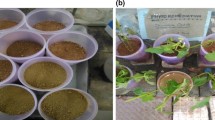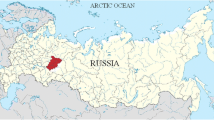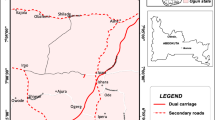Abstract
Large oilfields are often coincidentally located in major river deltas and wetlands, and potentially damage the structure, function and ecosystem service values of wetlands during oil exploration. In the present study, the effects of crude oil contamination during oil exploration on soil physical and chemical properties were investigated in marshes of the Momoge National Nature Reserve in Jilin Province, China. The concentrations of total petroleum hydrocarbons in the marsh soil near the oil wells are significantly higher than those in the adjacent control marsh. Soil water contents in oil-contaminated marshes are negatively correlated with soil temperature and are significantly lower than those in the control area, especially in fall. Crude oil contamination significantly increases the soil pH up to 8.0, and reduces available phosphorus concentrations in the soil. The concentrations of total organic carbon are significantly different among sampling sites. Therefore, crude oil contamination could potentially alkalinize marsh soils, adversely affect soil fertility and physical properties, and cause deterioration of the marshes in the Momoge National Nature Reserve. Phyto-remediation by planting Calamagrostis angustifolia has the potential to simultaneously restore and remediate the petroleum hydrocarbon-contaminated wetlands. Crude oil contamination affects the soil physical and chemical properties, so developing an effective restoration program in the Momoge wetland is neccesary.
Similar content being viewed by others
References
Agbogidi O M, Eruotor P G, Akparobi S O et al., 2007. Evaluation of crude oil contaminated soil on the mineral nutrient elements of maize (Zea mays L.). Journal of Agronomy, 6(1): 188. doi: 10.3923/ja.2007.188.193
Aislabie J M, Balks M R, Foght J M et al., 2004. Hydrocarbon spills on Antarctic soils: Effects and management. Environmental Science & Technology, 38(5): 1265–1274. doi: 10.1021/es0305149
Arocena J M, Rutherford P M, 2005. Properties of hydrocarbon- and salt-contaminated flare pit soils in northeastern British Columbia (Canada). Chemosphere, 60(4): 567–575. doi: 10.1016/j.chemosphere.2004.12.077
Bai J H, Wang Q G, Deng W et al., 2012. Spatial and seasonal distribution of nitrogen in marsh soils of a typical floodplain wetland in Northeast China. Environmental Monitoring and Assessment, 184(3): 1253–1263. doi: 10.1007/s10661-011-2037-3
Bao Shidan, 1999. Measurement of organic matter content in soil. In: Bao Shidan et al. (eds.). Analysis of Agri-chemistry in Soil (3rd ed.). Beijing: Chinese Agricultural Science and Technology Press, 25–38. (in Chinese)
Benka-Coker M O, Ekundayo J A, 1995. Effects of an oil spill on soil physico-chemical properties of a spill site in the Niger delta area of Nigeria. Environmental Monitoring and Assessment, 36(2): 93–104. doi: 10.1007/BF00546783
Bennett P C, Siegel D E, Baedecker M J et al., 1993. Crude oil in a shallow sand and gravel aquifer—I. Hydrogeology and inorganic geochemistry. Applied Geochemistry, 8(6): 529–549. doi: 10.1016/0883-2927(93)90012-6
Braddock J F, Ruth M L, Catterall P H et al., 1997. Enhancement and inhibition of microbial activity in hydrocarbon-contaminated arctic soils: Implications for nutrient-amended bioremediation. Environmental Science & Technology, 31(7): 2078–2084. doi: 10.1021/es960904d
Ekundayo E O, Obuekwe C O, 1997. Effects of an oil spill on soil physico-chemical properties of a spill site in a Typic Paleudult of midwestern Nigeria. Environmental Monitoring and Assessment, 45(2): 209–221. doi: 10.1023/A:1005776514235
Ekundayo E, Obuekwe O, 2000. Effects of an oil spill on soil physico-chemical properties of a spill site in a typic udipsamment of the Niger delta basin of Nigeria. Environmental Monitoring and Assessment, 60(2): 235–249. doi: 10.1023/A:1006230025095
Eneje R C, Nwagbara C, Uwumarongie-Ilori E G, 2012. Amelioration of chemical properties of crude oil contaminated soil using compost from Calapoigonium mucunoides and poultry manure. International Research Journal of Agricultural Science and Soil Science, 2(6): 246–251.
Gong Z, Li P, Wilke B M et al., 2008. Effects of vegetable oil residue after soil extraction on physical-chemical properties of sandy soil and plant growth. Journal of Environmental Sciences, 20: 1458–1462. doi: 10.1016/S1001-0742(08)62549-8
Hu Yalin, Wang Silong, Yan Shaokui, 2006. Research advances on the factors influencing the activity and community structure of soil microorganism. Chinese Journal of Soil Science, 37(1): 170–176. (in Chinese)
Jia Jianli, Liu Ying, Li Guanghe et al., 2009. Contamination characteristics and its relationship with physicochemical properties of oil polluted soils in oilfields of China. Chemical Industry and Engineering Society of China, 60(3): 726–732. (in Chinese)
Jiang M, Lu X G, Xu L S et al., 2007. Flood mitigation benefit of wetland soil—A case study in Momoge National Nature Reserve in China. Ecological Economics, 61(2): 217–223. doi: 10.1016/j.ecolecon.2006.10.019
Jobson A, McLaughlin M, Cook F et al., 1974. Effect of amendments on the microbial utilization of oil applied to soil. Applied Microbiology, 27(1): 166–171.
Khamehchiyan M, Hossein Charkhabi A, Tajik M, 2007. Effects of crude oil contamination on geotechnical properties of clayey and sandy soils. Engineering Geology, 89(3): 220–229. doi: 10.1016/j.enggeo.2006.10.009
Kisic I, Mesic S, Basic F et al., 2009. The effect of drilling fluids and crude oil on some chemical characteristics of soil and crops. Geoderma, 149(3–4): 209–216. doi: 10.1016/j.geoderma. 2008.11.041
Labud V, Garcia C, Hernandez T, 2007. Effect of hydrocarbon pollution on the microbial properties of a sandy and a clay soil. Chemosphere, 66(10): 1863–1871. doi: 10.1016/j.chemosphere. 2006.08.021
Leahy J G, Colwell R R, 1990. Microbial degradation of hydrocarbons in the environment. Microbiological Reviews, 54(3): 305–315.
Lin Q, Mendelssohn I A, 1996. A comparative investigation of the effects of Louisiana crude oil on the vegetation of fresh, brackish, and salt marsh. Marine Pollution Bulletin, 32(2): 202–209. doi: 10.1016/0025-326X(95)00118-7
Lin Q, Mendelssohn I A, 2009. Potential of restoration and phytoremediation with Juncus roemerianus for diesel-contaminated coastal wetlands. Ecological Engineering, 35: 85–91. doi: 10.1016/j.ecoleng.2008.09.010
Lin Q, Mendelssohn I A, 2012. Impacts and recovery of the deepwater horizon oil spill on vegetative structure and function of coastal salt marsh in the northern Gulf of Mexico. Environmental Science & Technology, 46(7): 3737–3743. doi: 10.1021/es203552p
Liu Wuxing, Luo Yongming, Teng Ying et al., 2007. Eco-risk assessment and bioremediation of petroleum contaminated soil. II Changes in physico-chemical properties and microbial ecology of petroleum contaminated soil. Acta Pedologica Sinica, 44(5): 848–853. (in Chinese)
Mendelssohn I, Anderson G, Baltz D et al., 2012. Oil impacts to coastal wetland: Implications for the Mississippi River Delta ecosystem after the deepwater horizon oil spill. Biosciences, 62(6): 562–574. doi: 10.1525/bio.2012.62.6.7
Mishra S, Sarma P M, Lal B, 2004. Crude oil degradation efficiency of a recombinant Acinetobacter baumannii strain and its survival in crude oil-contaminated soil microcosm. FEMS Microbiology Letters, 235(2): 323–331. doi: 10.1111/j.1574-6968.2004.tb09606.x
Njoku K, Akinola M, Oboh B, 2009. Phytoremediation of crude oil contaminated soil: The effect of growth of Glycine max on the physico-chemistry and crude oil contents of soil. Nature and Science, 7(10): 79–87.
Osuji L C, Egbuson E J, Ojinnaka C M, 2006. Assessment and treatment of hydrocarbon inundated soils using inorganic nutrient (NPK) supplements:. A case study of En II eka oil spillage in Niger Delta, Nigeria. Environmental Monitoring and Assessment, 115(1): 265–278. doi: 10.1007/s10661-006-6552-6
Quyum A, Achari G, Goodman R, 2002. Effect of wetting and drying and dilution on moisture migration through oil contaminated hydrophobic soils. Science of the Total Environment, 296(1): 77–87. doi: 10.1016/S0048-9697(02)00046-3
Riser-Roberts E, 1998. Optimization of bioremediation. In: Riser-Roberts (ed.). Remediation of Petroleum Contaminated Soils: Biological, Physical and Chemical Processes. New York: Lewis Publisher, 218–314.
Roy J L, McGill W B, Rawluk M D, 1999. Petroleum residues as water-repellent substances in weathered nonwettable oil-contaminated soils. Canadian Journal of Soil Science, 79(2): 367–380. doi: 10.4141/S97-040
Schoenau J J, O’Halloran I P, 2008. Sodium bicarbonate-extractable phosphorus. In: Gregorich E G et al. (eds.). Soil Sampling and Methods of Analysis (2nd ed.). New York: Chemical Rubber Company Press, Taylor & Francis Group, 94–95.
Sutton N B, Maphosa F, Morillo J A et al., 2013. Impact of long-term diesel contamination on soil microbial community structure. Applied and Environmental Microbiology, 79(2): 619–630. doi: 10.1128/AEM.02747-12
Townsend G T, Prince R C, Suflita J M, 2003. Anaerobic oxidation of crude oil hydrocarbons by the resident microorganisms of a contaminated anoxic aquifer. Environmental Science & Technology, 37(22): 5213–5218. doi: 10.1021/es0264495
Wang X Y, Feng J, Zhao J M, 2010. Effects of crude oil residuals on soil chemical properties in oil sites, Momoge Wetland, China. Environmental Monitoring and Assessment, 161(1): 271–280. doi: 10.1007/s10661-008-0744-1
Wang Xiaoyu, Feng Jiang, Wang Jing, 2009. Petroleum hydrocarbon contamination and impact on soil characteristics from oilfield in Momoge wetland. Environmental Science, 30(8): 2394–2401. (in Chinese)
Wilke B M, 2005. Determination of chemical and physical soil properties. In: Margesin R et al. (eds.). Manual for Soil Analysis Monitoring and Assessing Soil Bioremediation (Soil Biology, Vol. 5). Berlin Heidelberg, Germany: Springer-Verlag, 47–95.
Xu Qingtao, Gu Dongmei, 2003. Environmental resources and developing countermeasuer of wetland of Momoge National Natural Reserve. Journal of Agricultural Science Yanbian University, 25(1): 47–49. (in Chinese)
Yuan Jiadong, Zhang Na, Cao Yimin, 2005. Protection and development of tourism resource in Momoge National Natural Reserve. Journal of Northeast Normal University (Natural Science Edition), 37(3): 109–114. (in Chinese)
Author information
Authors and Affiliations
Corresponding author
Additional information
Foundation item: Under the auspices of National Natural Science Foundation of China (No. 31170476), Chinese Academy of Sciences/State Administration of Foreign Experts Affairs International Partnership Program for Creative Research Teams (No. KZZD-EW-TZ-07), Major Program of Science and Technology of Jilin Province (No. 20075014), Fundamental Research Funds for the Central Universities of China (No.11GJHZ002) Corresponding author: WANG Guoping.
Rights and permissions
About this article
Cite this article
Wang, Y., Feng, J., Lin, Q. et al. Effects of crude oil contamination on soil physical and chemical properties in Momoge wetland of China. Chin. Geogr. Sci. 23, 708–715 (2013). https://doi.org/10.1007/s11769-013-0641-6
Received:
Accepted:
Published:
Issue Date:
DOI: https://doi.org/10.1007/s11769-013-0641-6




